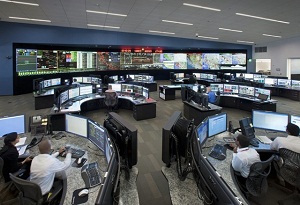California opens new grid-monitoring system with renewables station
 It looks like the helm of a spaceship. With a series of screens stretching over 80 feet wide and a desk dedicated entirely to monitoring renewable energy like solar and wind, the California Independent System Operator Corp.’s (ISO) is well positioned to monitor the growing amount of renewable energy joining the state’s electric grid and respond to the anticipated 47,814 megawatts of demand expected this year.
It looks like the helm of a spaceship. With a series of screens stretching over 80 feet wide and a desk dedicated entirely to monitoring renewable energy like solar and wind, the California Independent System Operator Corp.’s (ISO) is well positioned to monitor the growing amount of renewable energy joining the state’s electric grid and respond to the anticipated 47,814 megawatts of demand expected this year.
The organization, which is responsible for monitoring most of the electric grid activity in California, introduced its new monitoring center on earth day last week.
The control center has the first dedicated renewables-only dispatch desk in North America, according to ISO. The station uses advanced geospatial technology and visualization tools to help the operator better anticipate swings in wind and solar production, allowing ISO to prepare for bringing additional generating capacity online or reducing it as weather patterns shift.
“Our renewables desk is manned 24/7 by one operator working a 12-hour shift,” said ISO spokesperson Steven Greenlee.
At the same time, ISO introduced a new web portal, Solar Today, allowing anyone to see how much solar and wind are being generated in the state and how much energy is being used at any given time. The site shows how much solar and wind are being produced in the state at a near real-time rate.
“Its launch coincided with the creation of the renewables-only desk, and they were separate projects,” Greenlee said. “Managing renewables is not easy and remains a challenging endeavor, but the new system makes it possible to see market and grid conditions on a more granular level.”
The new control center, partly powered by a 750-kilowatt solar array, was built with the future in mind, according to Greenlee.
“In time, our new center will be able to embrace technologies such as synchrophasors that will take a snapshot of grid conditions every few milliseconds,” he said. “This in turn helps operators better balance supply and demand in real time in the most cost efficient manner possible.”
When operating, the California grid must balance the renewables with other energy sources, and it does so first through energy efficiency, then by demand response, Greenlee said.
The pecking order is renewables, solar energy and then conventional electric generation.
“When the ISO needs units to ramp up or ramp down to backstop variable generation, as often is the case, it looks first to the wholesale market where ancillary-services energy is offered and market software automatically selects the best bid offer,” he said. “Most usually, fast responding units are natural gas.”
While California currently has more wind generation, solar is starting to pick up. That’s a good thing. Solar is the more reliable of the two, according to Greenlee.
“While wind can suddenly drop off, the sun keeps shining and thus is more predictable,” he said. “Our challenge with solar is clouds, which can disrupt solar generation output [dust and air moisture content are problematic as well].”



